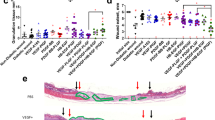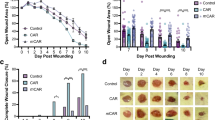Abstract
Insulin-like growth factor-I (IGF-I) and keratinocyte growth factor (KGF) cDNA gene transfer individually improves dermal and epidermal regeneration. The aim of the present study was to determine whether the combination of IGF-I plus KGF cDNA further improves wound healing and by which mechanisms these changes occur. Rats received an acute wound and were divided into four groups to receive weekly subcutaneous injections of liposomes plus Lac Z cDNA, liposomes plus IGF-I cDNA, liposomes plus KGF cDNA, or liposomes plus IGF-I/KGF cDNA. Planimetry, immunological assays, histological and immunohistochemical techniques were used to determine IGF-I, KGF, platelet-derived growth factor, fibroblast growth factor (FGF), transforming growth factor-β and vascular endothelial growth factor (VEGF) expression and different types of collagen (I, III and IV). IGF-I, KGF and their combination cDNA treatment significantly (P<0.05) accelerated re-epithelization, increased IGF-I, KGF, FGF, VEGF and collagen type IV expression, while it had no effect on collagen type I and III expression. The combination of IGF-I plus KGF cDNA increased (P<0.05) neovascularization and VEGF expression when compared to IGF-I cDNA, KGF cDNA groups and controls. In conclusion, exogenous administration of liposomal IGF-I plus KGF cDNA enhanced dermal and epidermal regeneration which is due to increased neovascularization.
This is a preview of subscription content, access via your institution
Access options
Subscribe to this journal
Receive 12 print issues and online access
$259.00 per year
only $21.58 per issue
Buy this article
- Purchase on Springer Link
- Instant access to full article PDF
Prices may be subject to local taxes which are calculated during checkout




Similar content being viewed by others
References
Alexander MY, Akhurst RJ . Liposome-medicated gene transfer and expression via the skin. Hum Mol Genet 1995; 4: 2279–2285.
Caracciolo G, Pozzi D, Caminiti R, Congiu Castellano A . Structural characterization of a new lipid/DNA complex showing a selective transfection efficiency in ovarian cancer cells. Eur Phys J E Soft Matter 2003; 10: 331–336.
Ito I, Began G, Mohiuddin I, Saeki T, Saito Y, Branch CD et al. Increased uptake of liposomal–DNA complexes by lung metastases following intravenous administration. Mol Ther 2003; 7: 409–418.
Mahato RI, Anwer K, Tagliaferri F, Meaney C, Leonard P, Wadhwa MS et al. Biodistribution and gene expression of lipid/plasmid complexes after systemic administration. Hum Gene Ther 1998; 9: 2083–2099.
Jeschke MG, Barrow RE, Hawkins HK, Tao Z, Perez-Polo JR, Herndon DN . Biodistribution and feasibility of non-viral IGF-I gene transfers in thermally injured skin. Lab Invest 2000; 80: 151–158.
Singer AJ, Clark RA . Cutaneous wound healing. N Engl J Med 1999; 341: 738–746.
Sun L, Xu L, Chang H, Henry FA, Miller RM, Harmon JM et al. Transfection with aFGF cDNA improves wound healing. J Invest Dermatol 1997; 108: 313–318.
Nakamura N, Shino K, Natsuume T, Horibe S, Matsumoto N, Kaneda Y et al. Early biological effect of in vivo gene transfer of platelet-derived growth factor (PDGF)-B into healing patellar ligament. Gene Therapy 1998; 5: 1165–1170.
Jeschke MG, Barrow RE, Hawkins HK, Yang K, Hayes RL, Lichtenbelt BJ et al. IGF-I gene transfer in thermally injured rats. Gene Therapy 1999; 6: 1015–1020.
Jeschke MG, Richter G, Hofstadter F, Herndon DN, Perez-Polo JR, Jauch KW . Non-viral liposomal keratinocyte growth factor (KGF) cDNA gene transfer improves dermal and epidermal regeneration through stimulation of epithelial and mesenchymal factors. Gene Therapy 2002; 9: 1065–1074.
Jeschke MG, Schubert T, Klein D . Exogenous liposomal IGF-I cDNA gene transfer leads to endogenous cellular and physiological responses in an acute wound. Am J Physiol Regul Integr Comp Physiol 2004; 286: R958–R966.
Jeschke MG, Klein D . Liposomal gene transfer of multiple genes is more effective than gene transfer of a single gene. Gene Therapy 2004; 11: 847–855.
Tonnesen MG, Feng X, Clark RA . Angiogenesis in wound healing. J Investig Dermatol Symp Proc 2000; 5: 40–46.
Ferrara N . Vascular endothelial growth factor and the regulation of angiogenesis. Recent Prog Horm Res 2000; 55: 15–35; discussion 35-16.
Swift ME, Kleinman HK, DiPietro LA . Impaired wound repair and delayed angiogenesis in aged mice. Lab Invest 1999; 79: 1479–1487.
Finch PW, Rubin JS, Miki T, Ron D, Aaronson SA . Human KGF is FGF-related with properties of a paracrine effector of epithelial cell growth. Science 1989; 245: 752–755.
Werner S, Smola H, Liao X, Longaker MT, Krieg T, Hofschneider PH et al. The function of KGF in morphogenesis of epithelium and reepithelialization of wounds. Science 1994; 266: 819–822.
Wheeler CJ, Felgner PL, Tsai YJ, Marshall J, Sukhu L, Doh SG et al. A novel cationic lipid greatly enhances plasmid DNA delivery and expression in mouse lung. Proc Natl Acad Sci USA 1996; 93: 11454–11459.
Marchese C, Sorice M, De Stefano C, Frati L, Torrisi MR . Modulation of keratinocyte growth factor receptor expression in human cultured keratinocytes. Cell Growth Differ 1997; 8: 989–997.
Martin P . Wound healing – aiming for perfect skin regeneration. Science 1997; 276: 75–81.
Redd MJ, Cooper L, Wood W, Stramer B, Martin P . Wound healing and inflammation: embryos reveal the way to perfect repair. Philos Trans R Soc Lond B Biol Sci 2004; 359: 777–784.
Jeschke MG, Barrow RE, Hawkins HK, Chrysopoulo MT, Perez-Polo JR, Herndon DN . Effect of multiple gene transfers of insulinlike growth factor I complementary DNA gene constructs in rats after thermal injury. Arch Surg 1999; 134: 1137–1141.
Jeschke MG, Herndon DN, Baer W, Barrow RE, Jauch KW . Possibilities of non-viral gene transfer to improve cutaneous wound healing. Curr Gene Ther 2001; 1: 267–278.
Herndon DN, Wilmore DW, Mason Jr AD . Development and analysis of a small animal model simulating the human postburn hypermetabolic response. J Surg Res 1978; 25: 394–403.
Acknowledgements
This study was supported by the Deutsche Forschungsgemeinschaft (DFG Je 233/2-3) and the Clayton Foundation for Research.
Author information
Authors and Affiliations
Corresponding author
Rights and permissions
About this article
Cite this article
Jeschke, M., Herndon, D. The combination of IGF-I and KGF cDNA improves dermal and epidermal regeneration by increased VEGF expression and neovascularization. Gene Ther 14, 1235–1242 (2007). https://doi.org/10.1038/sj.gt.3302972
Received:
Revised:
Accepted:
Published:
Issue Date:
DOI: https://doi.org/10.1038/sj.gt.3302972
Keywords
This article is cited by
-
Basic concepts, current evidence, and future potential for gene therapy in managing cutaneous wounds
Biotechnology Letters (2019)



